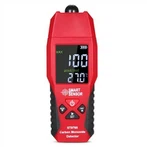Principle and advantages of non-contact temperature sensor
Non contact temperature sensor, whose sensitive element is not in contact with the measured object, is also known as non-contact temperature measuring instrument. This instrument can be used to measure the surface temperature of moving objects, small targets, and objects with small heat capacity or rapid temperature changes (transients), as well as to measure the temperature distribution of the temperature field.
Temperature sensors, the most commonly used non-contact temperature measuring instruments, are based on the fundamental law of blackbody radiation and are called radiation temperature measuring instruments. Radiation temperature measurement methods include brightness method (see optical pyrometer), radiation method (see radiation pyrometer), and colorimetric method (see colorimetric thermometer). Various radiation temperature measurement methods can only measure the corresponding photometric temperature, radiation temperature, or colorimetric temperature. Only the temperature measured for a blackbody (an object that absorbs all radiation but does not reflect light) is the true temperature. To determine the true temperature of an object, it is necessary to correct the emissivity of the material surface. The surface emissivity of materials depends not only on temperature and wavelength, but also on surface state, coating, and microstructure, making it difficult to measure accurately. In automated production, it is often necessary to use radiation thermometry to measure or control the surface temperature of certain objects, such as steel strip rolling temperature, roll temperature, forging temperature, and the temperature of various molten metals in smelting furnaces or crucibles in metallurgy.
In these specific situations, measuring the emissivity of an object's surface is quite difficult. For automatic measurement and control of solid surface temperature, additional mirrors can be used to form a blackbody cavity together with the measured surface. The effect of additional radiation can increase the effective radiation and effective emission coefficient of the measured surface. By using the effective emission coefficient to adjust the measured temperature through instruments, the true temperature of the measured surface can be obtained. The most typical additional reflector is a hemispherical reflector. The diffuse radiation on the surface near the center of the sphere can be reflected back to the surface by the hemispherical mirror, forming additional radiation, thereby increasing the effective emission coefficient. In the formula, ε is the surface emissivity of the material, and ρ is the reflectivity of the reflector. As for the radiation measurement of the true temperature of gas and liquid media, the method of inserting a heat-resistant material tube to a certain depth to form a blackbody cavity can be used. Calculate the effective emission coefficient of the cylindrical cavity after reaching thermal equilibrium with the medium. In automatic measurement and control, this value can be used to correct the measured chamber bottom temperature (i.e. medium temperature) and obtain the true temperature of the medium.






